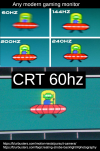Actually there is merit in the idea.I see, it's a resampler, not just a bit-depth-increaser.
In real life it's hard to imagine how this could really help fidelity or sound quality.
The only reason to use a sampling rate higher than 44.1khz is to represent frequencies higher than 22,500hz. Even if you could hear those frequencies, you'd have to be adding content (what kind of content, anyway?) that doesn't exist in the original recording, for the ultimate analog output of the resampler to be any different than the original. Why would you want to do that?
By upsampling, one can implement more precise and sharper filtering. This can have benefits in-band. By shifting the filtering to higher frequencies and sharper slopes, one can have less audio band artefacts.
Think of it like watching a movie, not in standard 24 fps, but in 100 fps.
Not the same thing, but a loose comparison to show that faster moving objects would look smoother, eventhough, the eye can only manage 50fps or so.



